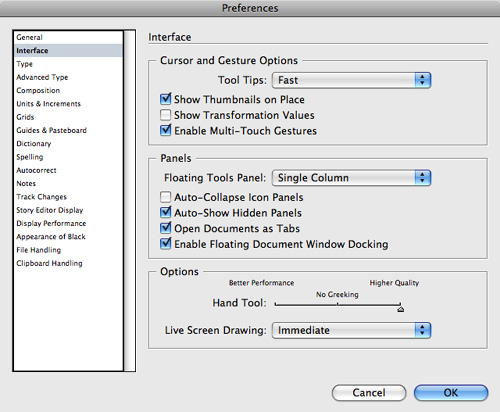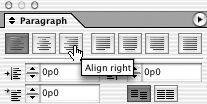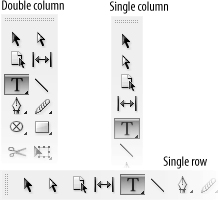The Interface preferences control how some aspects of the program appear
 . Tool tips are notes that appear when you pause the cursor over an onscreen element
. Tool tips are notes that appear when you pause the cursor over an onscreen element
 .
.
 The Interface settings of the Preferences dialog box.
The Interface settings of the Preferences dialog box.

 An example of a tool tip that appears when you pause over an interface element.
An example of a tool tip that appears when you pause over an interface element.

To control how quickly the tool tips are displayed
Use the Tool Tips menu to choose one of the following:
Normal waits a moment before displaying the tip. None turns off the display of the tips. Fast displays the tool tips almost immediately.
|
The Cursor Options let you change how the mouse cursor behaves.
To change the place cursor preview
Deselect the option Show Thumbnails on Place to see only the cursor, and not the thumbnail preview, for placed text and images
 .
.
 The thumbnail preview next to the Place cursor.
The thumbnail preview next to the Place cursor.

|
To change transformation preview
Deselect
the option Show Transformation Values to see only the cursor, and not
the transformation values as you draw and modify objects
 .
.
 The transformation values that appear as you create or modify objects.
The transformation values that appear as you create or modify objects.

|
You can also control whether InDesign allows you to use the multi-touch gestures for trackpads and mice.
To control trackpad gestures
Deselect
the option Enable Multi-Touch Gestures to avoid input by two or three
fingers on trackpads and mice that use that feature.
|
The default for the Tools panel is a single column. But you can change that setting.
To change the display of the Tools panel
Use the Floating Tools Panel menu to choose how the Tools panel is displayed
 :
:
Double column shows the tools vertically in two columns. Single column shows the tools vertically in a single column. Single row arranges the tools horizontally in a single row.
 The arrangements for the Tools panel.
The arrangements for the Tools panel.

|
Tip
Click the two arrows in the Tools panel title bar to shift between the three settings when it is not docked.
You can also change how the panels and documents behave.
To change how docked panels collapse
Select Auto-Collapse Icon Panels to cause selected docked panels to automatically close when you move back to a document.
|
To change how hidden panels are displayed
Select
Auto-Show Hidden Panels to display any panels that were hidden by
pressing Tab or Shift-Tab when the cursor moves over the hidden panel
area.
|
To change how new documents appear
Select Open Documents as Tabs to combine the windows for new documents into a tabbed display
 .
.
 An example of documents arranged in tabs.
An example of documents arranged in tabs.

|
To change how documents can be docked to others
Select
Enable Floating Document Window Docking to allow floating document
windows to dock as tabs into other windows while being dragged.